Ryan Hall's Blog, page 363
August 21, 2015
Strengthen Your Core With Abdominal Rollouts
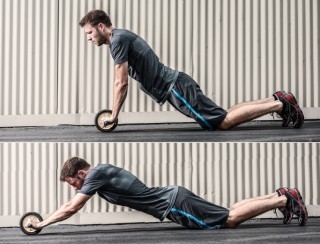
Photo: Scott Draper
While standard crunches work your abdominal muscles and flex your spine, the abdominal rollout—which requires an ab wheel—works the entire core region, including the rectus abdominus, the internal and external obliques as well as the transverse abdominus. These muscles help keep your body upright and stable when running.
“It’s a great exercise, and one of my favorites,” says Pascal Dobert, a three-time U.S. 3,000-meter steeplechase champion who is now a strength and conditioning coach for Nike. “It activates your core region in a way that is applicable to movement.”
How to do it:
Step 1: Get on your knees, preferably on a soft surface or mat.
Step 2: Grab the wheel with both hands and slowly roll out toward a fixed surface such as a wall or pillar. Keep the elbows straight and maintain a neutral spine. Then roll back to your starting position. The farther you reach out with the wheel, the more difficult the exercise becomes, Dobert warns. He suggests rolling out to a distance that’s comfortable and sustainable for 10–12 reps. Aim for two sets.
RELATED: The Best Core Exercise for Proper Running Form
The post Strengthen Your Core With Abdominal Rollouts appeared first on Competitor.com.
Eliminate Knee Problems With The Chair Stretch
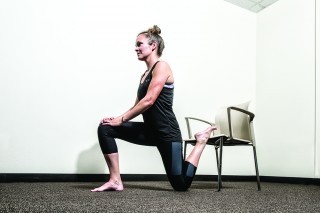
Photo: Scott Draper
Many knee issues, from IT Band Syndrome to a sore knee, are often rooted in the hips. The chair stretch can help fix the problem before it gets out of hand.
“The chair stretch is a simple body weight exercise used to open up the quadriceps and hip flexor muscles through hip extension,” says Zach Thew, owner of Catoctin CrossFit in Purcellville, Va.
How to do it:
Step 1: Using a chair or couch to support your rear leg, position yourself in what looks similar to a lunge stance. Keep your rear leg bent so that knee is resting on the ground. The foot of your lead leg should be planted firmly on the floor.
Step 2: Slowly raise your chest and aim to keep your shoulders and hips square. The top of the stretch is when your chest is upright and your butt is touching your rear heel, although that may prove difficult when you first start doing this stretch. “As your positioning improves in this stretch, you may begin to close the gap between your heel and glutes,” Thew says.
Step 3: Hold the stretch for up to 2 minutes before slowly lowering yourself and switching leg positions. “This can be used as a tool to mobilize the hip area before or after a training session,” Thew says.
RELATED: Injury Prevention 101: IT Band
The post Eliminate Knee Problems With The Chair Stretch appeared first on Competitor.com.
Running Form Drill: Backward Running
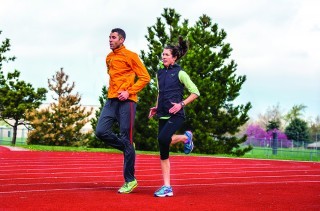
Photo: Scott Draper
Improve your efficiency with this classic drill.
Why?
If you’re always moving forward whenyou run, is there any reason to ever go in the opposite direction? The answer is yes. Just as you must propel yourself forward when setting out for a run, you must also launch yourself backward to get going in the opposite direction. The difference is in the primary muscles involved with each motion. Incorporating some backward running into your pre- or post-run drill routine can help improve your ability to cover ground in front of you more quickly and with enhanced efficiency.
How?
Run backward for 50 yards as part of a comprehensive drill routine. Remember to “run tall” and keep your core engaged while remaining in the sagittal plane and employing quick turnover. By pushing off your forefoot to run backward, the glutes and upper hamstrings lead the way, and get stronger as a result. Do two to four backward runs with 30 seconds of standing recovery between repetitions.
When?
Following one or two of your easy runs during the week, or after your warm-up for speed workouts.
RELATED:
— Essential Form Drills for Speed and Efficiency
— Improve Your Running Form With Classic A-Skips
The post Running Form Drill: Backward Running appeared first on Competitor.com.
13 Great Storylines at the 2015 World Track & Field Championships

The 2015 IAAF World Track & Field Championships, which will be held Aug. 22-30 in Beijing, China, will showcase some of the best athletes on the planet and perhaps offer a compelling sneak preview of the 2016 Olympics in Rio de Janeiro. This year’s championships will include 1,931 athletes (1042 men, 889 women) from 207 countries—a record for a championship of any single sport. The events will be broadcast on TV (on NBC Sports and Universal Sports in the U.S.) and via a livestream feed on IAAF’s YouTube channel to an estimated 6 million people. Here is a look at 13 compelling storylines in the championships.
RELATED: The U.S. Could Have One (or More!) 40-Something Olympians in 2016!
Photo Gallery
1 of {count}
Back to Start
View Larger Image

Usain Bolt is Back for More (Gold) Medals
Record-setting sprinter Usain Bolt of Jamaica returns to Beijing, where he became a breakout star at the 2008 Olympics. Although he's had an average year so far (his best time in the 100 this year is 9.87, which is only the sixth-fastest in the world), Bolt (shown above chillin' at the Temple of Confucius) says he's ready to defend his world titles. Since he became the world's top sprinter in 2008, the only blemish on his championships record is his infamous false start in the 100-meter dash at the 2011 world championships. Otherwise, he's won a total of 14 gold medals in the 100, 200 and 4x100 relay at the 2009, 2011 and 2013 world championships and 2008 and 2012 Olympics. Although he's only 28, he's said he'll retire after the 2017 world championships. Bolt will try to extend his golden streak in the 100 on Aug. 23, the 200 on Aug. 27 and the 4x100 relay on Aug. 29. Photo: Courtesy of Puma
View Larger Image

The Comeback Kid
American Aries Merritt ended the 2012 season as the Olympic champion and world record-holder (12.80 seconds) in the 110-meter high hurdles. But when he struggled the following year, doctors told him he had kidney disease—a rare genetic disorder, found predominantly in African Americans. Added to that, Merritt’s kidneys were being further attacked by parvovirus B16, which got into his kidneys and bone marrow and wreaked havoc on his body. Merritt was hospitalized from October 2013 to April 2014. When he checked in, his kidney function was down to 15 percent. He was treated with intravenous immune globulin to get rid of the parvovirus, which was his doctors’ main concern. Once that was out of his kidneys and bone marrow, the doctors attempted to recover what remaining kidney function the virus didn’t damage. Despite less than optimal kidney function, Merritt, now 30, salvaged his 2014 season with modest results and continued his comeback this year, which eventually resulted in a third-place showing at the U.S. championships in June. His best time of 13.12 seconds ranks No. 8 in the world this year. He is slated to have a kidney transplant on Sept. 1, just 4 days after the 100m hurdle final. Photo: PhotoRun.net
View Larger Image

Happy Birthday, Baby!
Exactly a year after giving birth to a baby girl (and just 14 months after jogging two laps in the prelims of the 800 at the 2014 U.S. championships while very pregnant), Alysia Montano is running in the world championships with a chance to earn a medal. Montano has already won two U.S. titles (indoor 600m, outdoor 800m) and a Pan American Games silver medal (800m) since having her baby last August. She's a six-time U.S. champion in the 800m and has twice finished fourth in the world championships. She owns a bronze medal from the 2010 world indoor championships and a fifth-place finish from the 2012 London Olympics. Montano, 29, runs her first prelim race on Aug. 26. Photos: PhotoRun.net
View Larger Image

Albertogate
In 2012, Alberto Salazar coach Mo Farah (right) and Galen Rupp (left) to gold and silver medals, respectively, in the 10,000-meter run in the London Olympics. (Farah also won gold in the 5,000, while Rupp was seventh.) In the ensuing years, Farah repeated his double-gold effort at the 2013 world championships, while Rupp went on to break the American record in the 10,000. But earlier this year, Salazar, the longtime Nike coach, former world-class marathoner and 1984 U.S. Olympian, was accused of numerous immoral and illegal practices by former athletes, staff members and assistant coaches. Salazar has offered rebuttals to suggest he's innocent of any wrongdoing and to date no anti-doping or criminal charges have been filed, but his coaching relationship with Farah has appeared to have gone a bit sideways. Both Rupp, 29, and Farah, 32, are entered in the 5,000- and 10,000-meter runs in Beijing. Photo: PhotoRun.net
View Larger Image
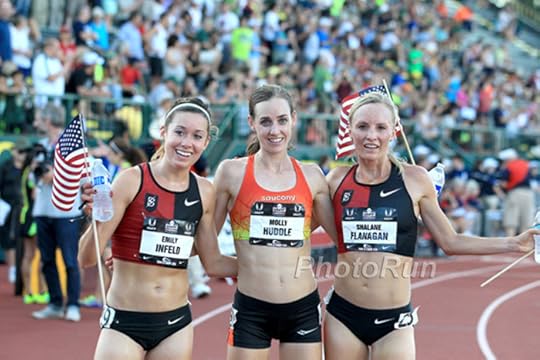
American Stars
While it wouldn't be fair to label the American trio of runners in the Aug. 24 10,000-meter run—Shalane Flanagan, Molly Huddle and Emily Infeld—the Past, the Present and the Future, it's certainly has some grounds for discussion. The 34-year-old Flanagan, who is still a world-class runner, earned a bronze medal (upgraded recently to silver) in the event at the 2008 Olympics in Beijing; Huddle, 30, is arguably the top distance runner in the U.S. right now and Infeld, 25, has made leaps and bounds progress over the past few years. Huddle won the 10,000 at the U.S. championships, less than 3 seconds ahead of Flanagan in second and Infeld in third. Photo: PhotoRun.net
View Larger Image
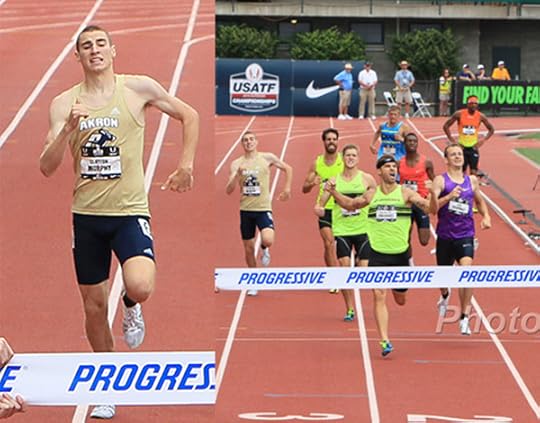
Clayton Murphy
Who is heck is Clayton Murphy? He's the guy who got promoted to the U.S. team after U.S. 800-meter champion Nick Symmonds was prohibited from joining the team for refusal to sign the USATF statement of conditions about sponsored gear. The 20-year-old Murphy, who will be a junior at the University of Akron this fall, has had a huge year already, lowering his PR by almost 5 seconds to 1:45.59, placing fourth at the U.S. championships and winning gold at the Pan American Games in Toronto. While it might be tough for him to make it through the qualifying rounds, nothing Murphy does should come as a surprise anymore and it's not too early to start talking about him making the 2016 U.S. Olympic team. Photo; PhotoRun.net
View Larger Image

Women's Metric Mile Madness
Four years ago, American Jenny Simpson shocked the world by winning the 1,500-meter run. But it wasn't a fluke; since that time the 28-year-old former steeplechase runner has been one of the world's most dominant runners in the metric mile, placing second in the 2013 world championships and finishing 2014 as the world's No. 1 ranked runner in that event. But it was two-time Olympian Shannon Rowbury, 30, (left) who broke the 32-year-old American record of Mary Decker Slaney by finishing a Diamond League race in Monaco in 3:56.29, a full second ahead of Simpson. Still, both of those efforts were overshadowed by Ethiopia's Genzebe Dibaba, who set a new world record with an amazing 3:50.07 effort. Heading into the championships, this trio ranks No. 1, 3 and 4 in the world. Photos: PhotoRun.net
View Larger Image

Marathon Showdown
With Kenyan Wilson Kipsang (33, former world record holder at 2:03:23, bronze medalist 2012 Olympics), Ugandan Stephen Kiprotich (26, 2012 Olympic champion and 2013 world champion) and Kenyan Dennis Kimmeto (31, current world record-holder at 2:02:57, two-time Berlin Marathon champion) entered in the men's marathon (plus 21 other runners with PRs under 2:10 and seven more under 2:07), the Aug. 22 men's marathon could be one of the most compelling marathon races in history. Championship races don't usually produce crazy-fast times, but even the tactical races have gotten faster with increased competition. If the weather is right and the Beijing smog isn't too bad, expect a sub-2:08 winning time. Photos: PhotoRun.net
View Larger Image
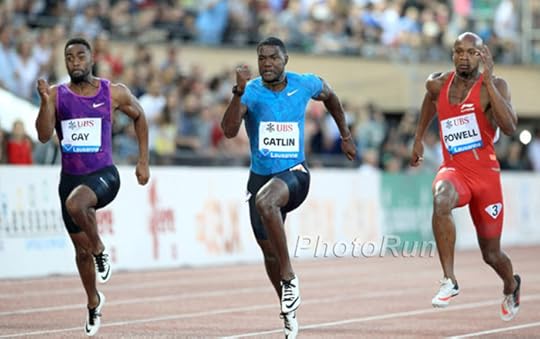
Dopers Run Free
C'mon, really?! Although the dark side of track and field is starting to get exposed this summer, the sport has yet to clean up its act. Case in point: the men's 100-meter dash final on Aug. 23 could feature these three convicted dopers—Americans Tyson Gay and Justin Gatlin and Jamaican Asafa Powell. They each blamed their positive tests on someone else and, somehow each had their doping bans reduced. Heading into the world championships, Gatlin, 33, is ranked No. 1 in the world in the 100 (9.74) and 200 (19.57), while Powell, 32, is No. 2 in the 100 (9.81) and Gay, 33, is No. 6 in the 100 (9.87). Photo: PhotoRun.net
View Larger Image

Is David Still Dominant?
Kenyan David Rudisha was already the world's most dominant 800-meter runner when he destroyed the world record with an eye-popping 1:40.91 effort at the 2012 London Olympics. He's since fallen from his perch a bit, as knee and calf injuries sidelined him for much of the past two years and he managed only a silver at the 2014 Commonwealth Games. But a 1:43.58 effort at the New York Diamond League meet in June (which ranks No. 8 in the world heading into the championships) shows the 26-year-old is almost back to top form. Photo: PhotoRun.net
View Larger Image
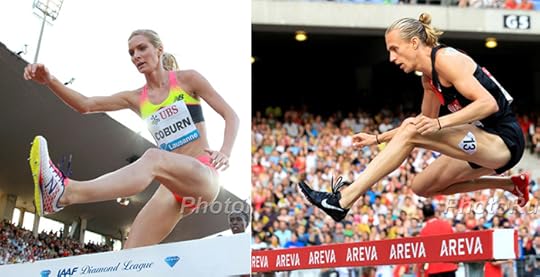
The 3,000m Steeplechase
Perhaps the most obscure event in all of running, the “steeple” is a savage compromise of strength, speed and endurance, and it entails running nearly 2 miles at a crazy-fast pace (about 4:50-mile pace for women, 4:20 for men) while negotiating 35 barriers—seven of them in front of a daunting water pit—in what might best resemble a sadistic equestrian event. It could get a lot more attention in the U.S. because rising stars (and American record-holders) Emma Coburn, 24, (left) and Evan Jager, 26, are contenders to earn medals at the world championships (the men's final is on Aug. 24, the women's final is on Aug. 26) but both should be even better a year from now at the 2016 Olympics. Photos: PhotoRun.net
View Larger Image
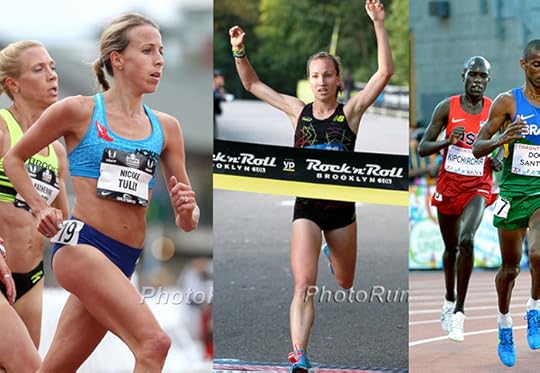
Unsung Americans
As is the case before every Olympic year, new faces have emerged as contenders for the 2016 U.S. Olympic team. Among the best stories are: Nicole Tully, 28, (left), who won the 5,000-meter run at the U.S. championships despite working a full-time job; Kerri Gallagher, 26, who was the surprise third-place finisher in the 1,500-meter run at the U.S. championships and lowered her PR from 4:09 to 4:03 to secure her spot on the U.S. team; and former Oklahoma State and Western Kentucky runner Shadrack Kipchirchir, a 26-year-old native of Kenya who runs for the U.S. Army World Class Athlete Program, was fourth in the 10,000-meter run at the U.S. championships and fourth at this summer's Pan American Games in Toronto. He made the team when Ben True (the runner-up in the 5,000 and 10,000 at the U.S. championship) decided to focus only on the 5,000. Photos: PhotoRun.net (2), Tim Hipps, U.S. Army IMCOM Public Affairs
Related Galleries
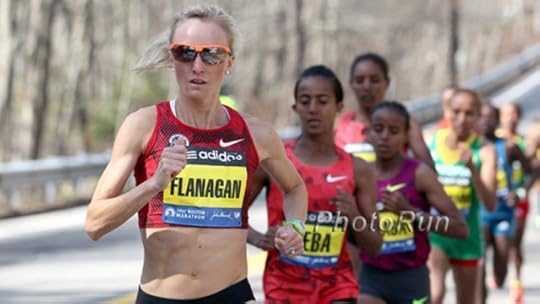
Sizing Up 2016: Who Will Make The U.S. Olympic Marathon Teams?

Photos: Over 20,000 Runners Rock Chicago!

Photos: Meet & Greet with Shalane Flanagan

Photos: 2014 New York Mini 10K

More Galleries
The post 13 Great Storylines at the 2015 World Track & Field Championships appeared first on Competitor.com.
August 20, 2015
How Cas Loxsom Is Preparing For The World Championships

Cas Loxsom crossed the line third in the 800m final at the U.S. Outdoor Championships, punching his ticket to Beijing. Photo: PhotoRun.net
Casimir (Cas) Loxsom has been blazing a fast track to success in 2015. The 24-year-old middle-distance runner, who finished third in the 800 meters at the U.S. Outdoor Championships in June and set an American record (1:15.33) in winning the 600 meters at the national indoor championships on March 1, will represent the U.S. at the IAAF World Championships in Beijing on Saturday when he lines up for the qualifying heats of the 800 meters.
The Seattle-based Loxsom, who trains as a member of the Brooks Beasts Track Club with six-time national 800m champion Nick Symmonds and 2015 U.S. indoor 600m runner-up Mark Wieczorek under the watchful eye of Beasts coach Danny Mackey, is hoping he can carry his momentum all the way through the August 23 semifinals and eventually into the finals on August 25.
We caught up with Loxsom and Mackey this week to see how he’s been preparing for the most important event of his life. Take their excellent advice to heart as you get ready for your own big races later this summer or fall.
1. He has a clearly defined training goal every day.
“Be intentional each day with a goal,” Mackey preaches in regard to training.
Loxsom usually does two traditional speed workouts a week, Mackey says, and during the meat of middle-distance training, time trials and fast 300 and 400-meter repetitions are commonplace.
“Six-hundred meter time trials and 3 x 400m are two really good indicator [workouts] for me,” says Loxsom. “If I can run in the 1:14 range or be able to complete 3 x 400 somewhere around 51, 50 and 49 [seconds], I’m in a good spot.”
A typical easy day for Loxsom consists of a 60-minute run on soft surfaces, usually at 6:50-7:15 per mile pace—or even slower if he’s feeling a little rough around the edges.
“I don’t get baited into fast runs too often,” Loxsom admits, “but if I’m feeling especially tired, I’ll often opt to run with the women’s team on easy days.
Mackey says he’ll also have Loxsom do “something fast”—but not a full workout—three times a week in addition to his easy runs so he’s never too far removed from the high-speed demands of world class middle-distance running.
“If it the goal for Cas is to recover, he recovers,” Mackey says. “If the goal is to run all out until he pukes, he’s done that too.”
2. He’s kept up with strength training and form drills.
Even while peaking for his biggest races of the season, Loxsom has kept up with his strength training program and regularly works on his running form.
“Lifting is a staple of my training. Improving my base strength in the weight room and dynamic explosiveness are assets for the power aspect of sprinting,” Loxsom says. “I’m always the most confident when I haven’t left anything undone. It’s easier said than done, but knowing I put the work in does wonders for confidence.”
Mackey says Loxsom hits the weight room twice a week throughout the season and completes a full-body routine consisting of Olympic lifts, multi-direction runner-specific lifts, core work and plyometrics. He also pays works on his running form multiple times a week, regularly doing a series of drills and short sprints on the track in addition to his more traditional speed workouts.
3. He keeps calm and works on his confidence.
Loxsom is a big believer in maintaining a consistent routine in the days leading up to a big race, which he says helps him stay calm and confident while preventing him from overthinking the task at hand.
“I try not to overthink big meets too much,” Loxsom says. “I lead each day as close to normal as I can and keep my mind off the race. If I stress out about it too early in the week, that can spell trouble.”
Mackey likes to weave mental training into Loxsom’s key speed workouts and has him visualize the various scenarios he might face in a high stakes situation. In a race that doesn’t even last for 2 minutes, being able to instinctually and confidently respond to a slow start, erratic pacing or unfortunate positioning is crucial to achieving your desired outcome.
“Sometimes I give simple cues to visualize an aspect of the race while he is running or right before a repeat,” Mackey says. “Yesterday, he did pace changes and was made aware of how he felt. Cas prefers to have one plan that is the focus—via splits at certain points in the race—and from there be aware and prepared since anything can happen.”
The post How Cas Loxsom Is Preparing For The World Championships appeared first on Competitor.com.
The World’s Steepest 400-Meter Race Comes to the United States

On Sept. 26, the world’s most extreme 400-meter race will be hosted in the U.S. for the first time at Olympic Park in Park City, Utah. The Red Bull 400 consists of sprinting 400 meters (or the equivalent of one lap around a track) up a ski slope with a vertical gain of 180 to 200 meters. With Park City already sitting at an elevation of 6,870 feet, this year’s event makes it the highest altitude Red Bull 400 ever organized, and even more challenging than its preceding courses in Europe.
The race was founded by former Austrian Olympic sprinter Andreas Berger in 2011 with the first race held on the Kulm ski slope in Austria. Last year’s race was held in Harrachov, Czech Republic.
This year, winners of the 5th annual climb (top man and woman) will be awarded an all-inclusive getaway to a secret location in Europe and $500 in cash. Registration is now open for those in the area and game for a solid quad-burning workout.
The post The World’s Steepest 400-Meter Race Comes to the United States appeared first on Competitor.com.
Video: Jenny Simpson on the Sacrifices of Professional Running

New Balance has put together a four-part “Steps to Beijing” documentary on Jenny Simpson as she prepares for the 2015 World Championships in Beijing, China. The third episode takes a look at the supporting cast that has helped her be one of the best runners in the world.
RELATED: Video: A Look at Jenny Simpson’s Training Routine
The post Video: Jenny Simpson on the Sacrifices of Professional Running appeared first on Competitor.com.
Lindsey Hein: Successful Training Means Appreciating the Process

Two years ago I ran an 11-minute personal best time in the marathon. It was nine months after I birthed baby number one. Once I had my son I was super focused on training and having a goal. I knew what I was capable of at the start of the race, and my day went according to plan. When I finished, I was ready to celebrate my accomplishment for a few weeks before digging right back in to running—something I believe is important to do.
I trained for a half Ironman that summer. In the fall, I ended up having surgery and yet another surgery in January. I registered for Boston knowing it would be soon after my second surgery. Instead of racing for a specific goal time, I decided to focus on the experience. I trained to build my mileage, and be prepared to run a marathon that wasn’t necessarily fast but was doable based upon where I was physically and mentally.
A month after Boston 2014 I found out I was pregnant with our second child. Fast-forward to this summer, and baby number two is now seven months old. I’m starting to feel fit and where I want to be physically. I’m even starting to feel confident about what I can do this fall at the Chicago Marathon. But it’s been a slow build. Progressing from walking and then running a couple times a week, I’ve made it to the point where I am now able to train six or seven days a week.
The point is you have to be realistic about your starting point. The specific times I once ran represent what I was capable of when I ran them. Now I’m working towards new goals. It doesn’t happen overnight.
Whether it’s a pregnancy, injury or an emotional or physical break that’s kept you from running at your peak, you simply cannot lace up and expect to perform at your historic best. If you try, you will likely get injured and be frustrated. It may sound harsh, but it’s the truth.
Sign up for races for the enjoyment factor and to track your progress. Just because you ran a certain time at a 5K two years ago, doesn’t mean you shouldn’t be proud of a 5K time that is a minute, or two, slower right now. Appreciate the process.
I have big goals for my fall marathon. They even seem a little daunting, but I know if I focus on the present, and make a little progress each week for the next 12 weeks, I’ll make big strides. You need to start where you are right now, not where you want to be. Your training should reflect that reality. Every couple of weeks reevaluate and see where you are and decide if it’s time to stay the course or make some pace adjustments and up your game.
The post Lindsey Hein: Successful Training Means Appreciating the Process appeared first on Competitor.com.
6 Ways to Carry Gels on Long Runs
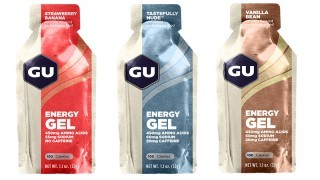
This article first appeared on Women’s Running.
With fall racing season right around the corner (how is the summer almost over?), longer weekend runs are becoming a norm for many of us.
One thing that goes hand in hand with longer running is the need for fuel while on the run—gels, chomps, beans, etc. Figuring out which works best for you and your body is hard enough, but then you have to also determine how you will carry your fuel. While it may not seem like such an important decision right now, it’s a great idea to try out a few during training so that you have practiced retrieving fuel while on the run for race day.
Here are a few ways to ensure you have the necessary fuel with you during a long training run or race:
Safety Pin to Shorts: The tried and true method for gels. Pin the top portion of the gel to the waistband of your shorts and just rip the lower section off when it’s time to take the gel! Play around with different techniques until you find one that works for you. Some runners like to keep them on the inside of their shorts; others prefer them hanging on the outside.
Shorts/Pants with Pockets: This past spring, I ran the Boston Marathon in the Saucony Bullet Tight Shorts. They feature two deep, fitted pockets (one on each side) that can hold multiple gels, a phone and whatever else you may need to carry. There is an endless number of shorts/pants on the market (Saucony makes the same design in a capri form) with pockets – either on sides or on back designed to help carry smaller objects for you.
Sports Bra: Your sports bra is a great storage area for fuel – but just be cautious about chaffing from the sharp edges of the packets. (There have been some horror stories about bad chaffing!) Some runners opt for the gels on the sides while others utilize the area in the middle.
Belted Pouch: Lots of options here including the SPI-belt, FlipBelt and Fitletic’s Running belt. These belts feature a non-bounce, fitted belt with large pocket that can hold a wide range of items including all types of fuel.
Hydration Device: If you are utilizing a backpack, handheld, vest or hydration belt, there often are additional pockets which provide room for other items, including your fuel.
Hold in Hand: While some runners may prefer to be hands free, this is the simplest and easiest method if you don’t mind having items in your hand over long periods of time. When the weather gets cold, you can utilize your gloves to do the work for you.
The post 6 Ways to Carry Gels on Long Runs appeared first on Competitor.com.
Running Tech Buzz: The Athlete’s Activity Tracker

Photo: Scott Draper
As a workout tracker, fitness monitor and multisport training tool in one, Moov is a seriously versatile device. From its perch on the ankle it records a multitude of information about running technique that a typical activity tracker or GPS watch cannot. Matched with the app, it’s a full-blown training Sherpa displaying speed and distance to go along with the stride data. Its catalog of pre-programmed audio workouts delivered through ear buds, though, isn’t ideally suited to distance running (but it offers plenty of cross-training workouts). For a single do-it-all device, use Moov (or the second-generation Moov Now, released last month) as an activity tracker between workouts and bring your phone along on runs or during cross-training sessions, including cycling, swimming and various gym-based activities, and all of your bases will be covered.
Breakdown
What it does
Moov tracks training—running and more—plus activity between workouts.
How it’s better
It’s a single device that performs two functions well.
Why you need it
Supercharge a workout-tracking app with data about your run technique.
RELATED: Running Tech Buzz: Sensoria Fitness Bundle
The post Running Tech Buzz: The Athlete’s Activity Tracker appeared first on Competitor.com.
Ryan Hall's Blog
- Ryan Hall's profile
- 21 followers



